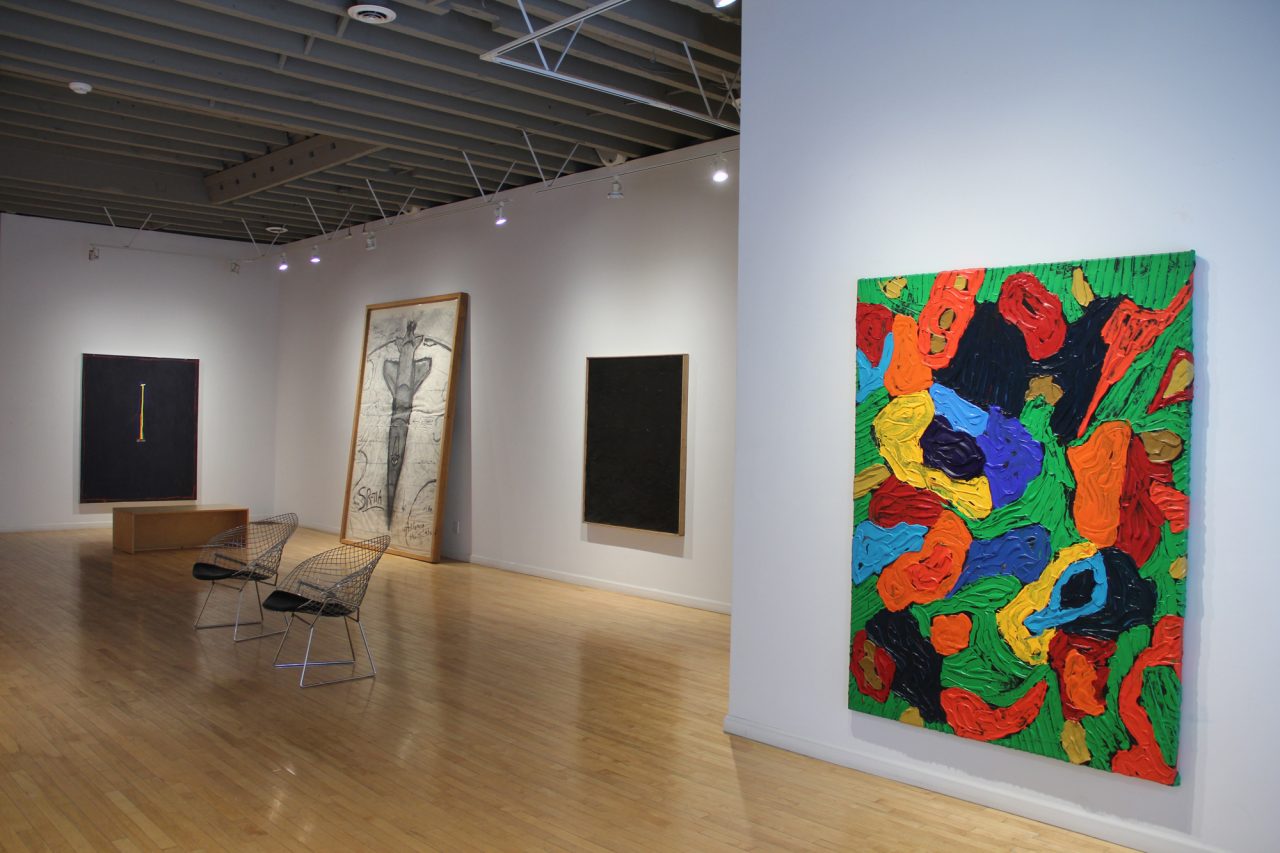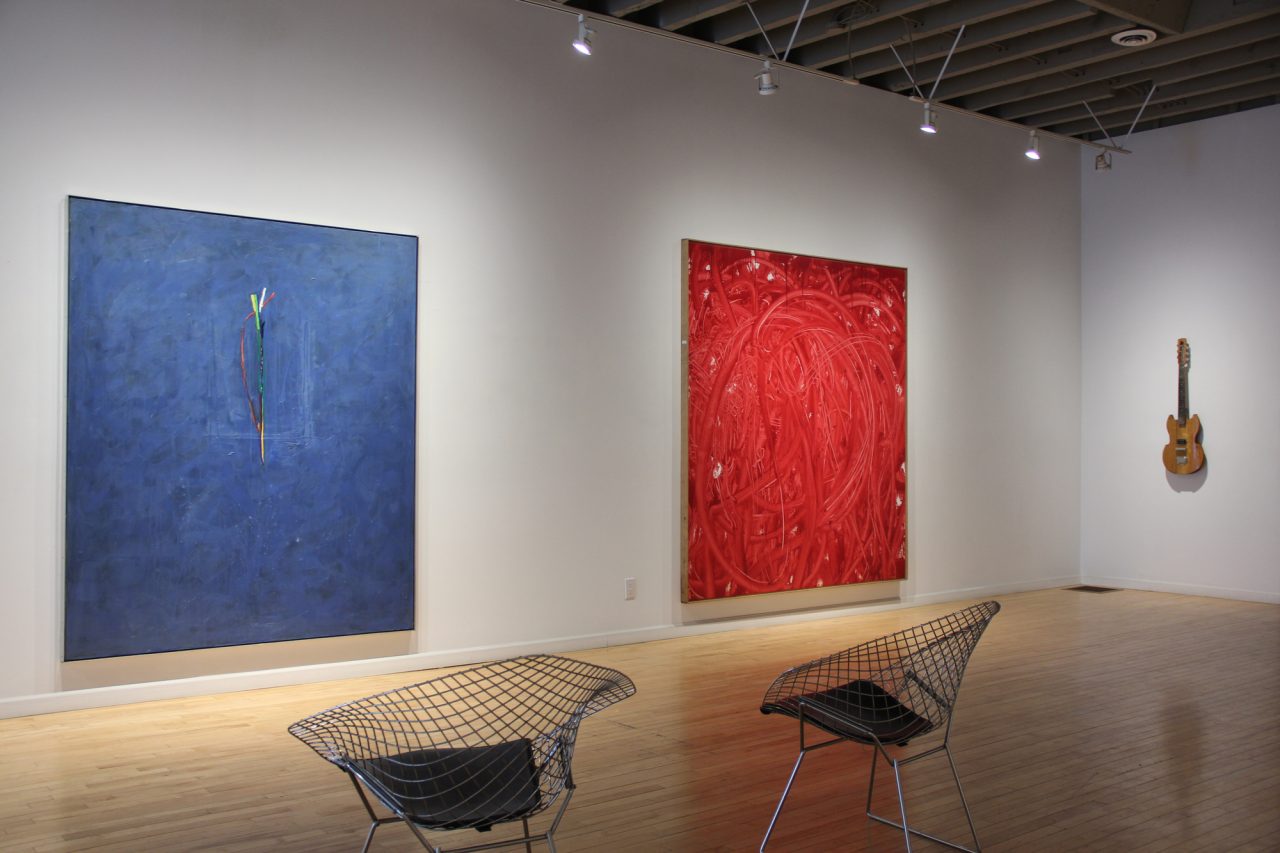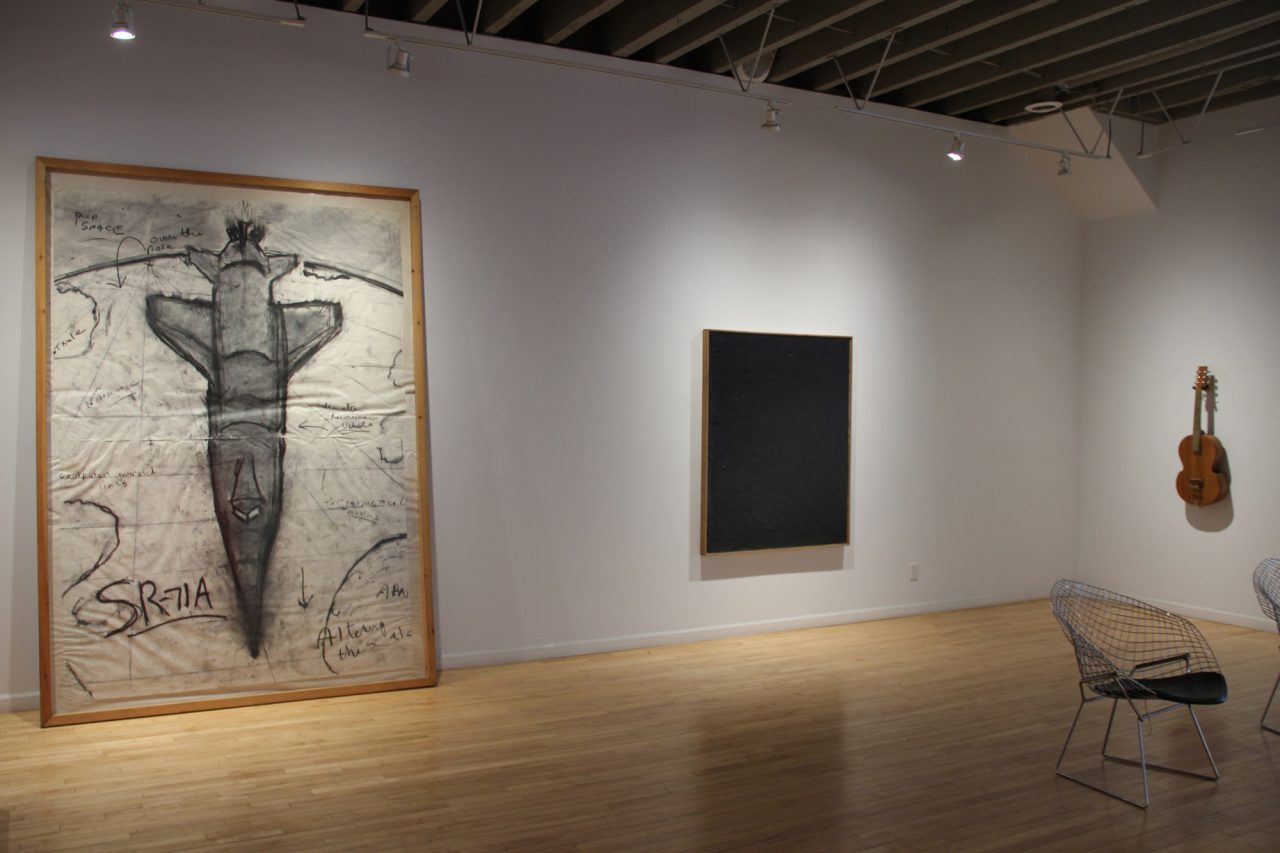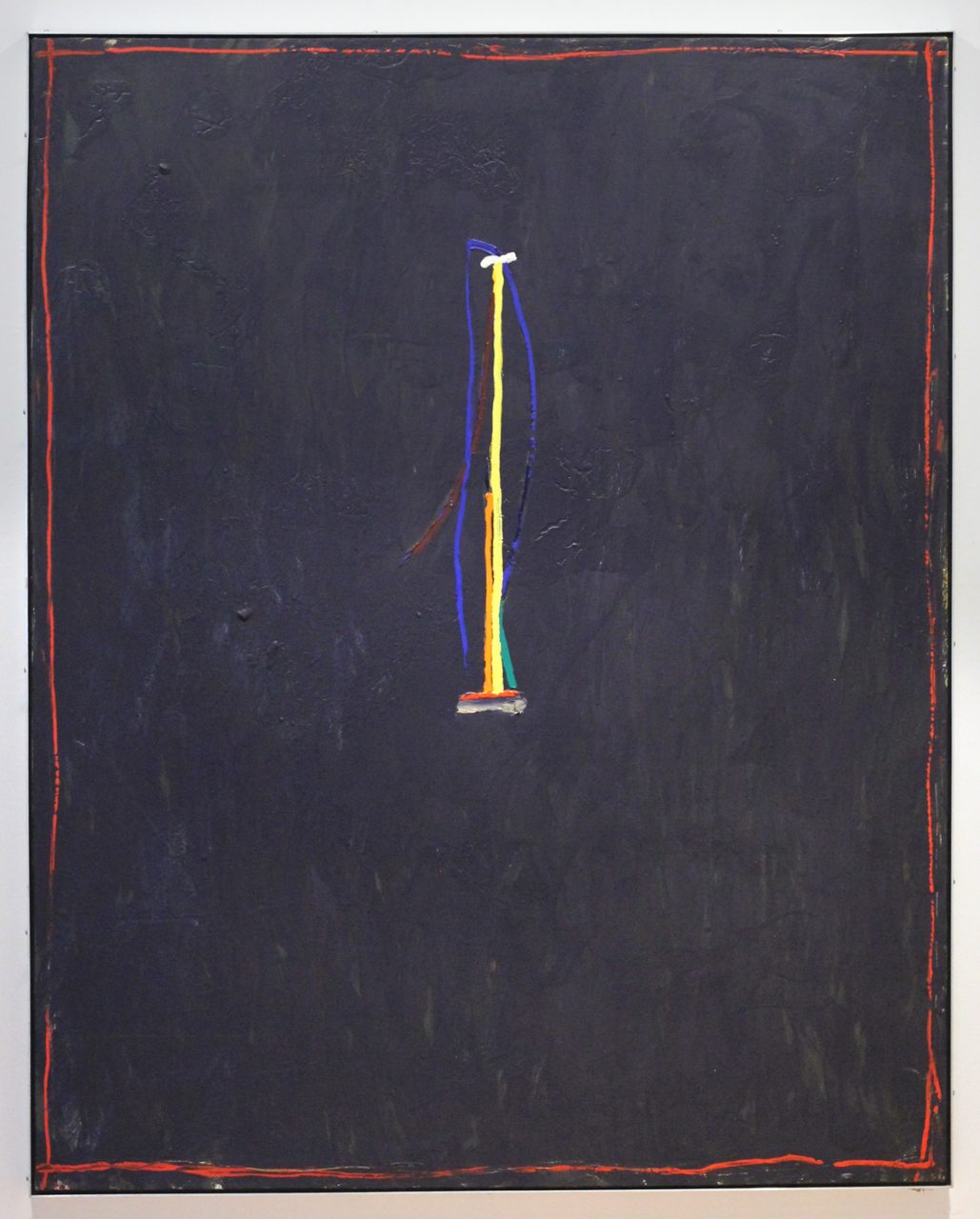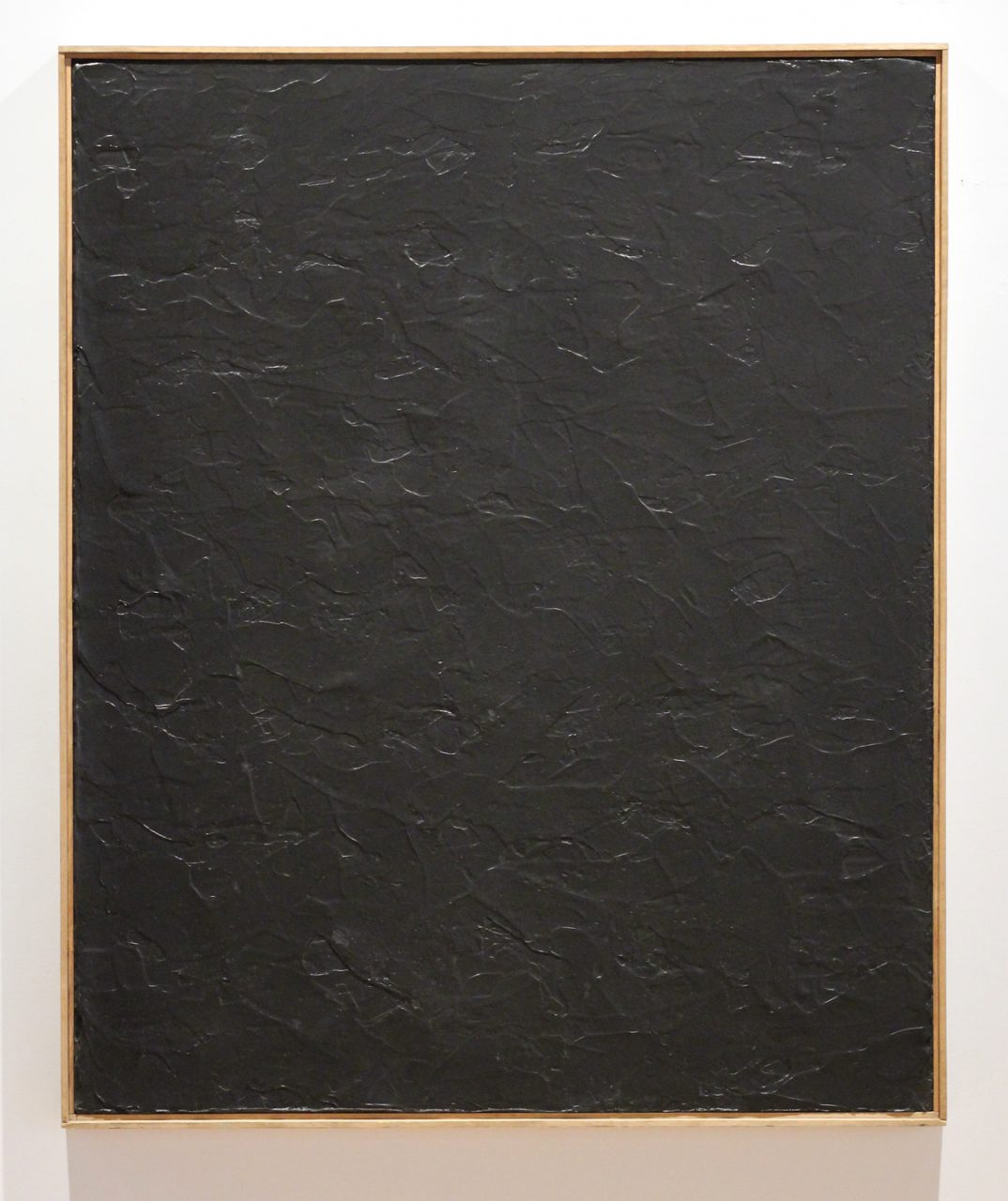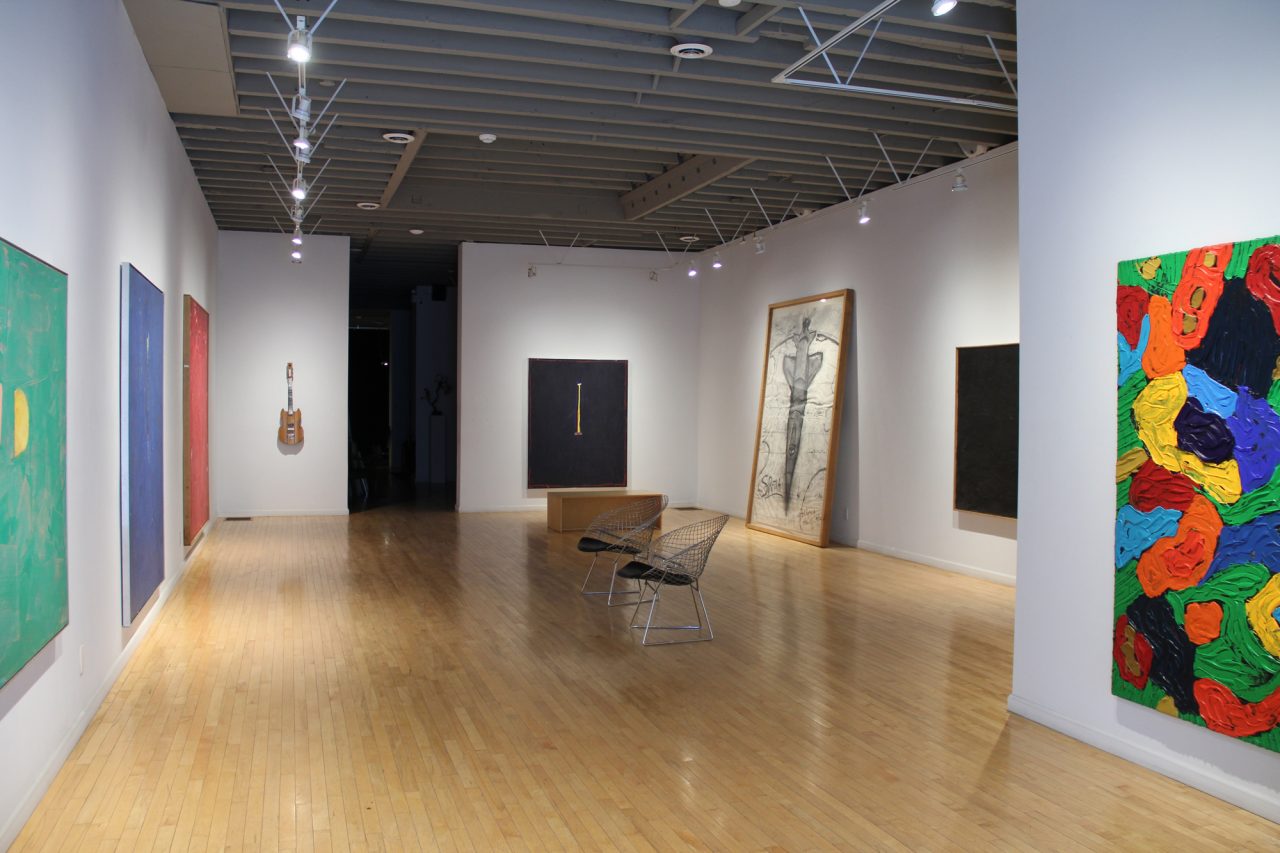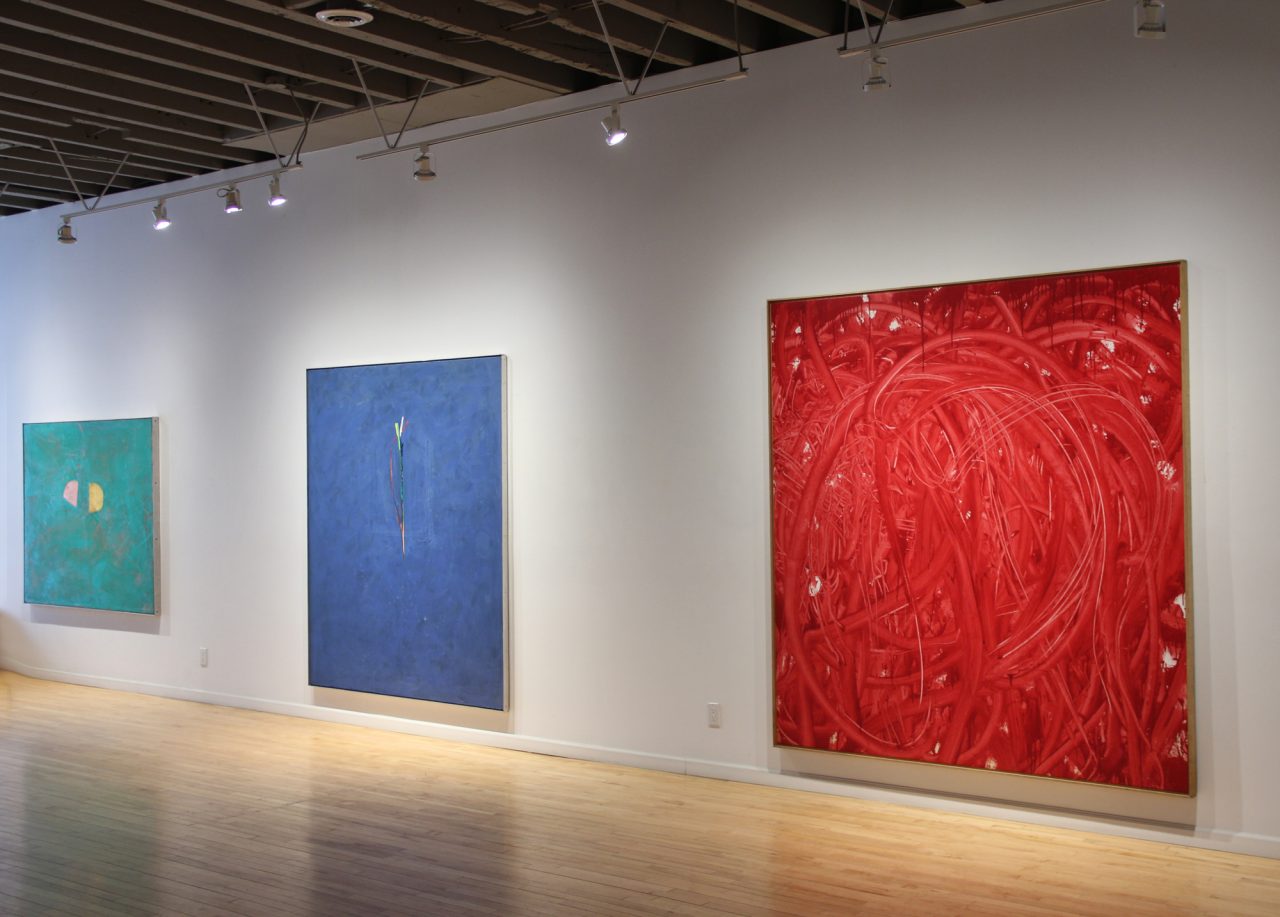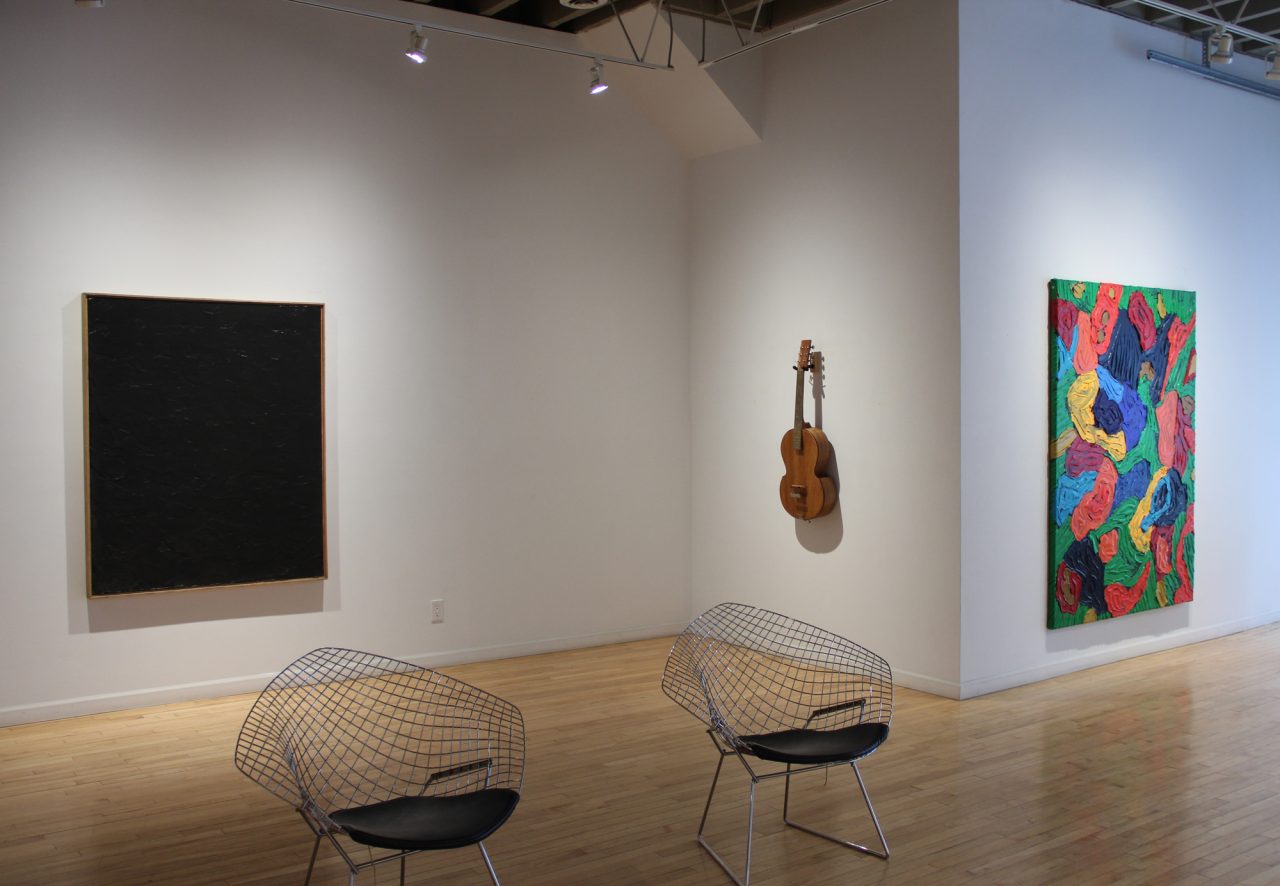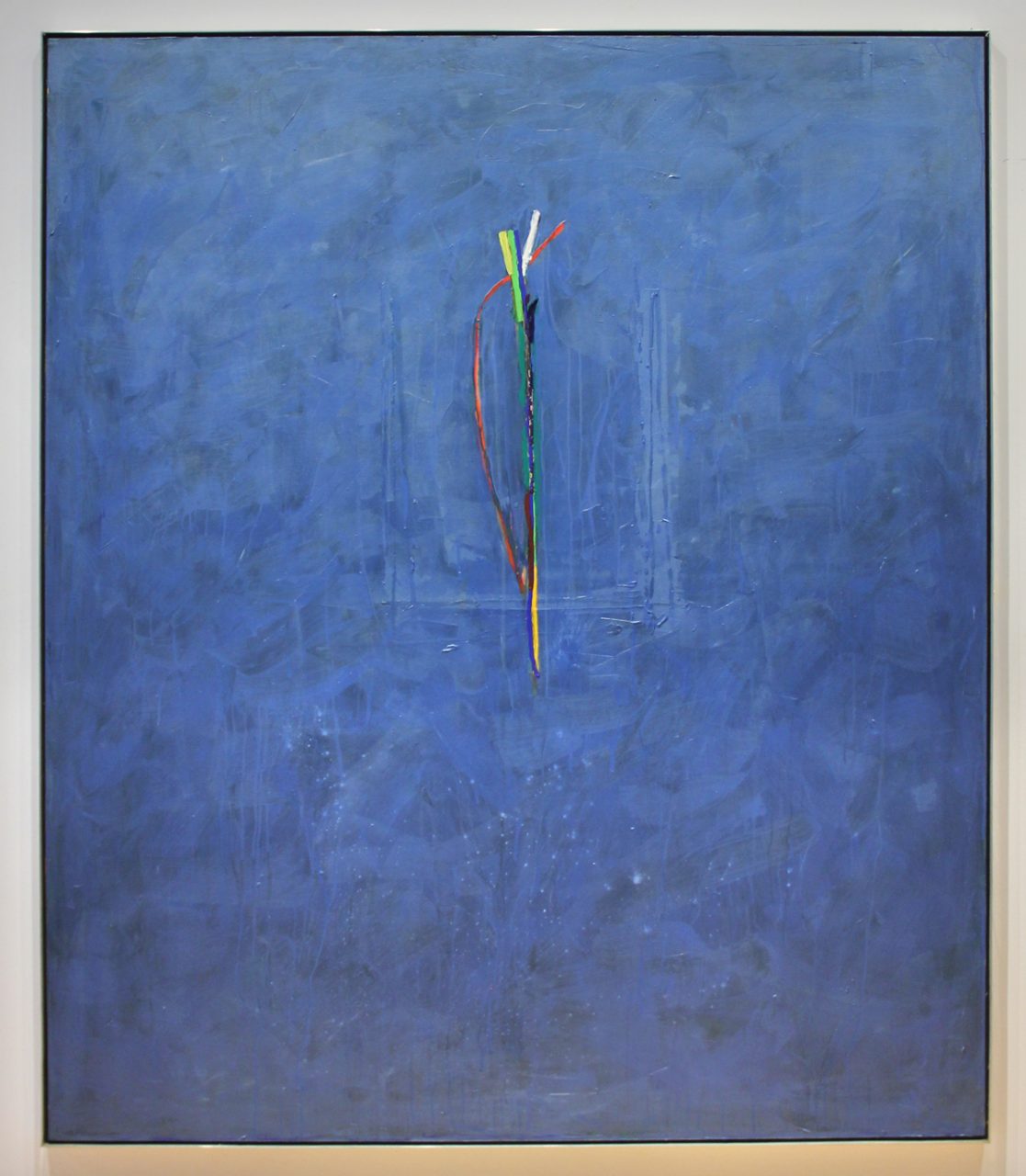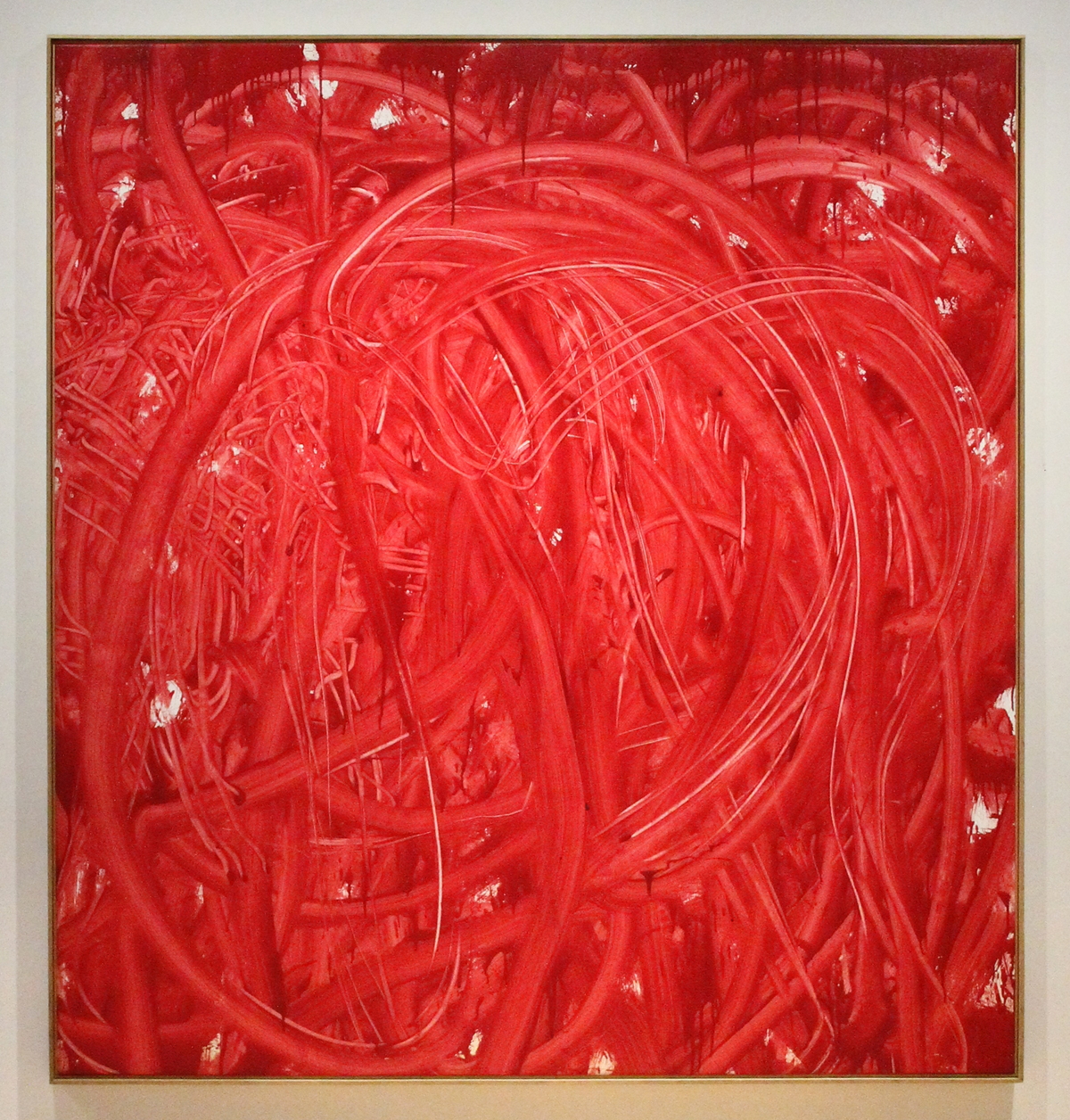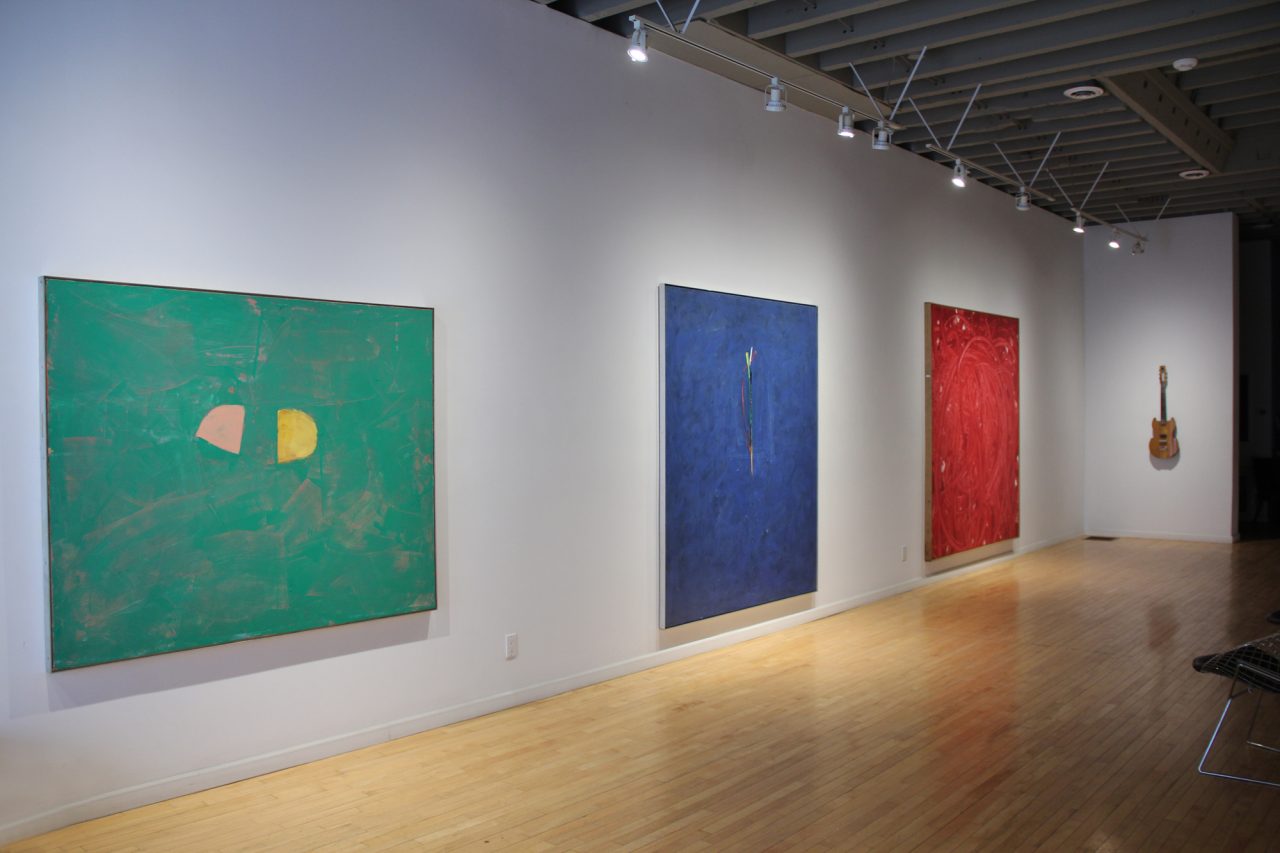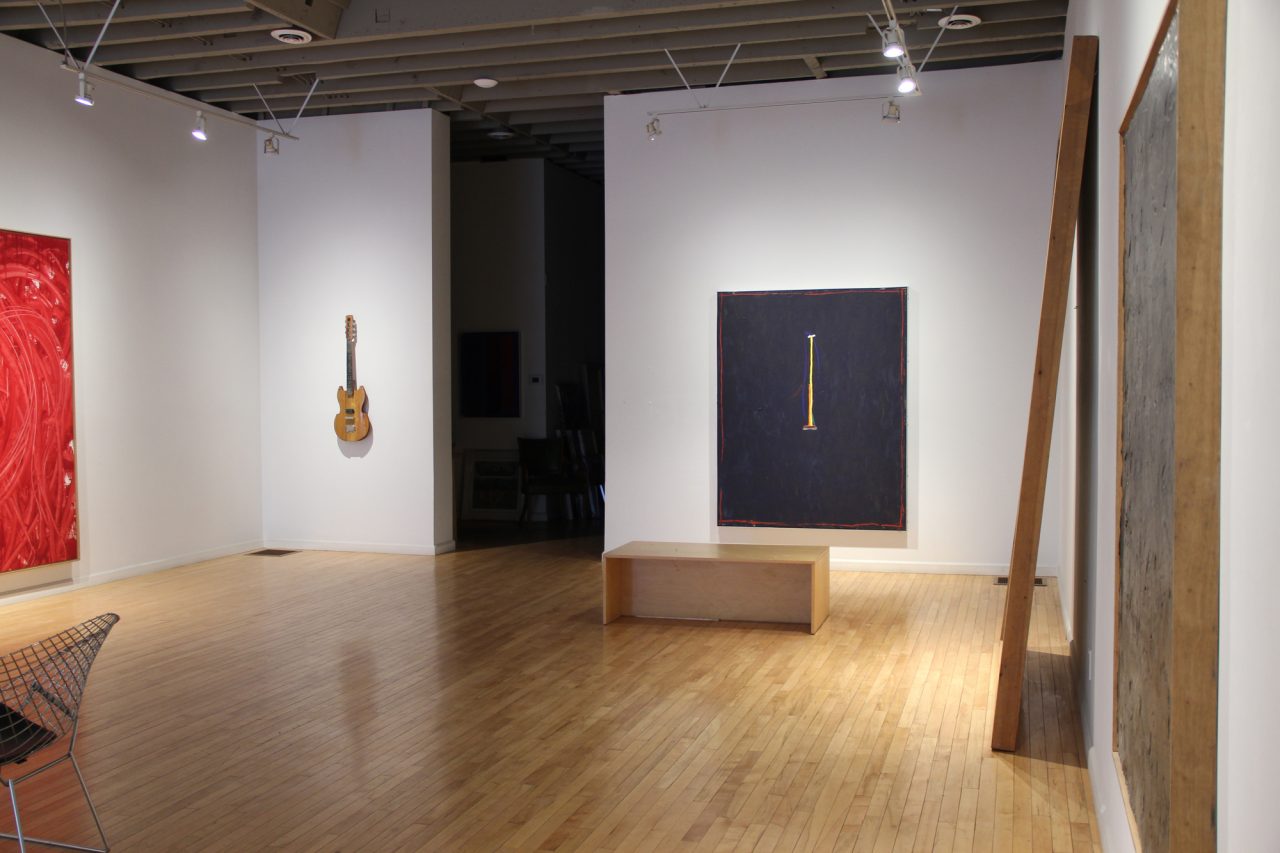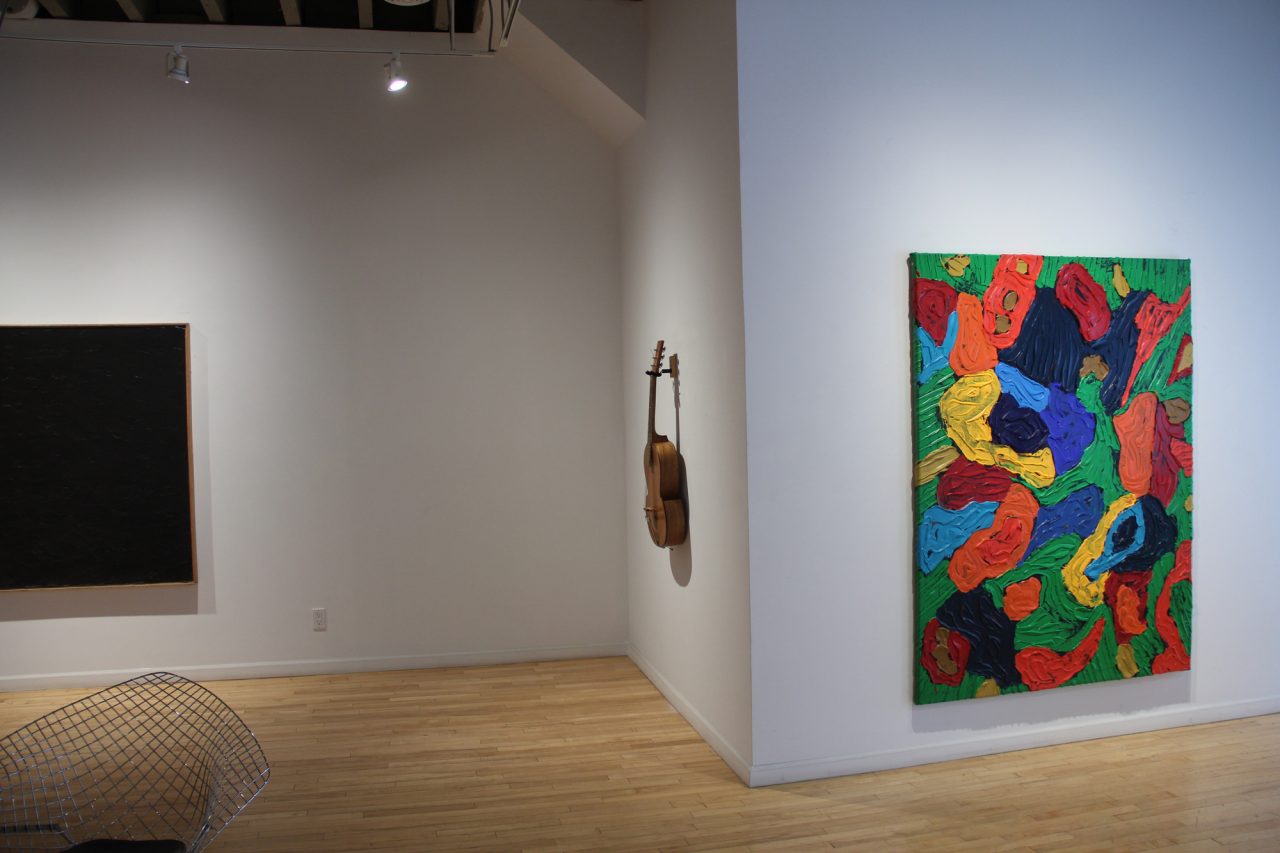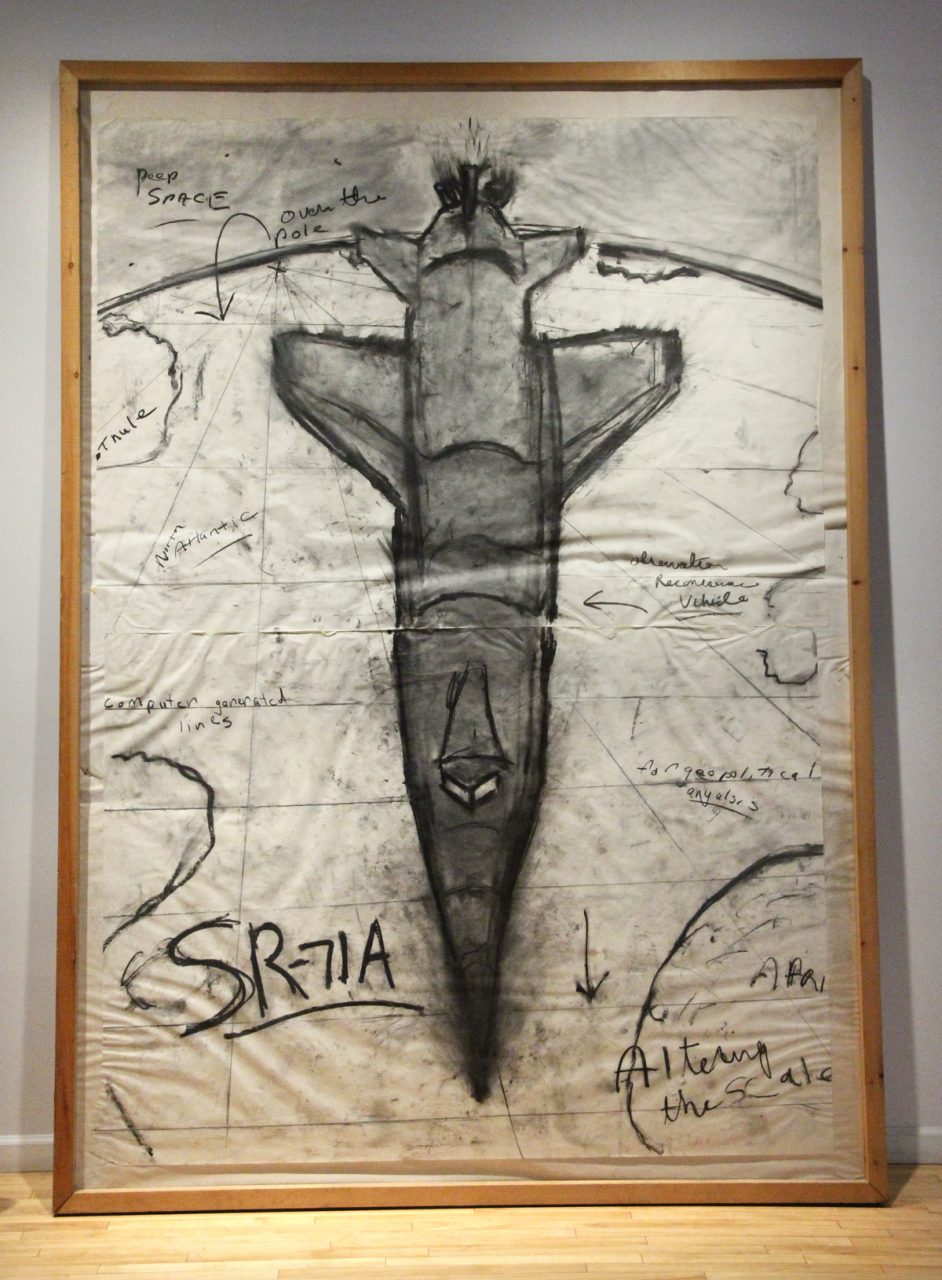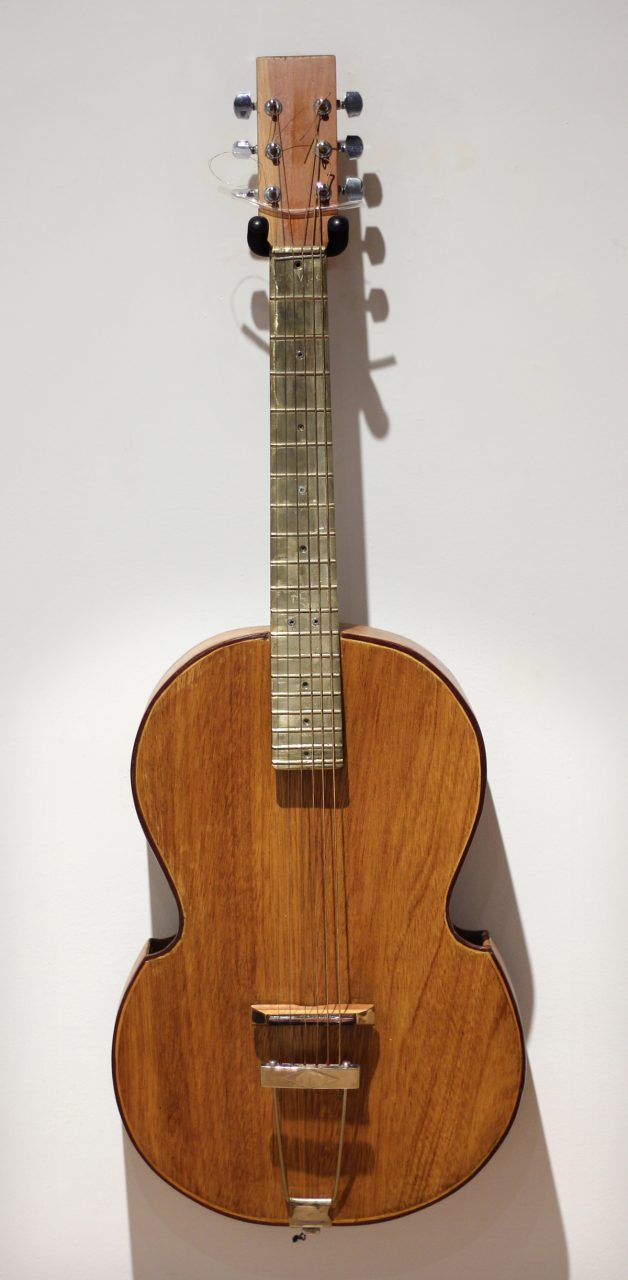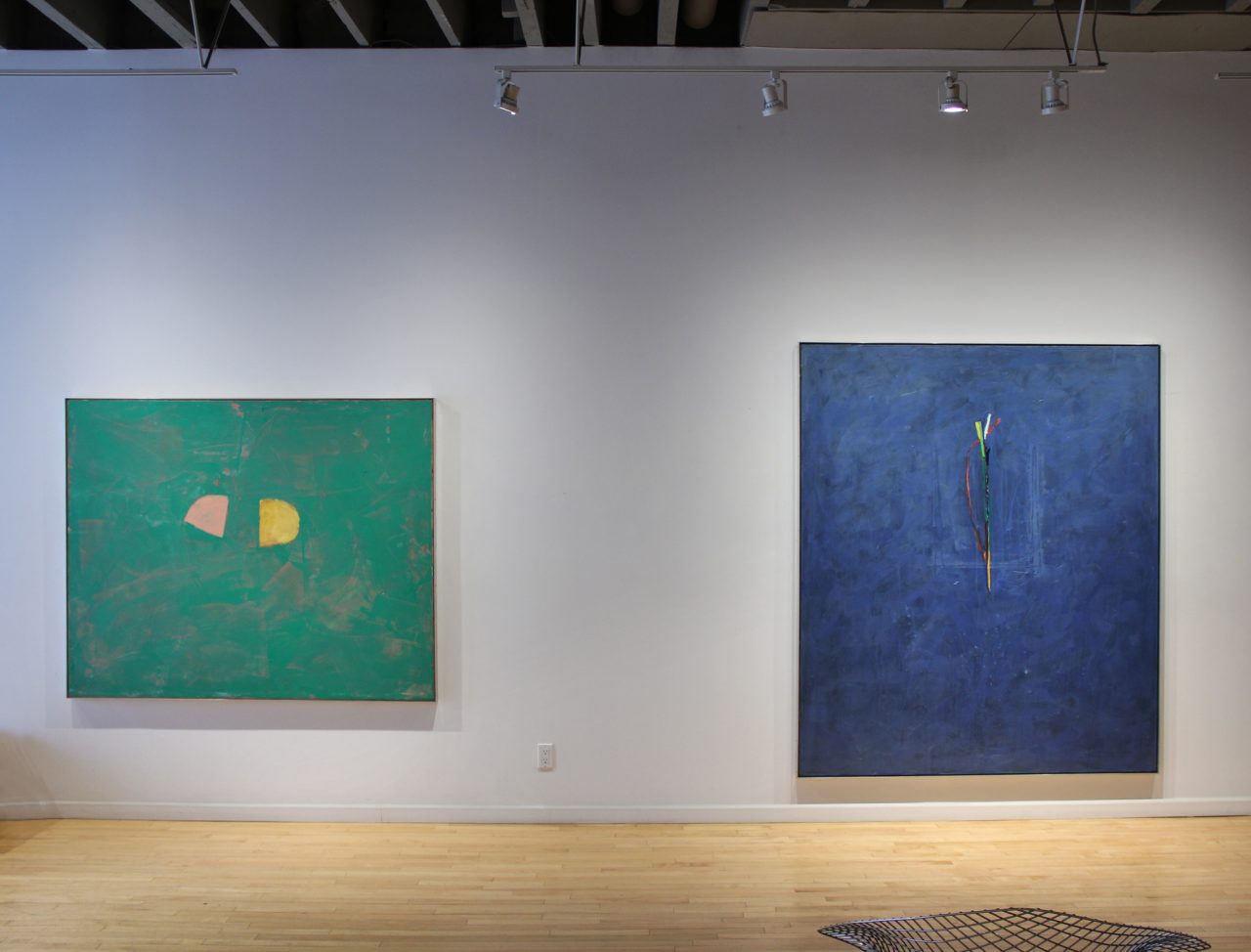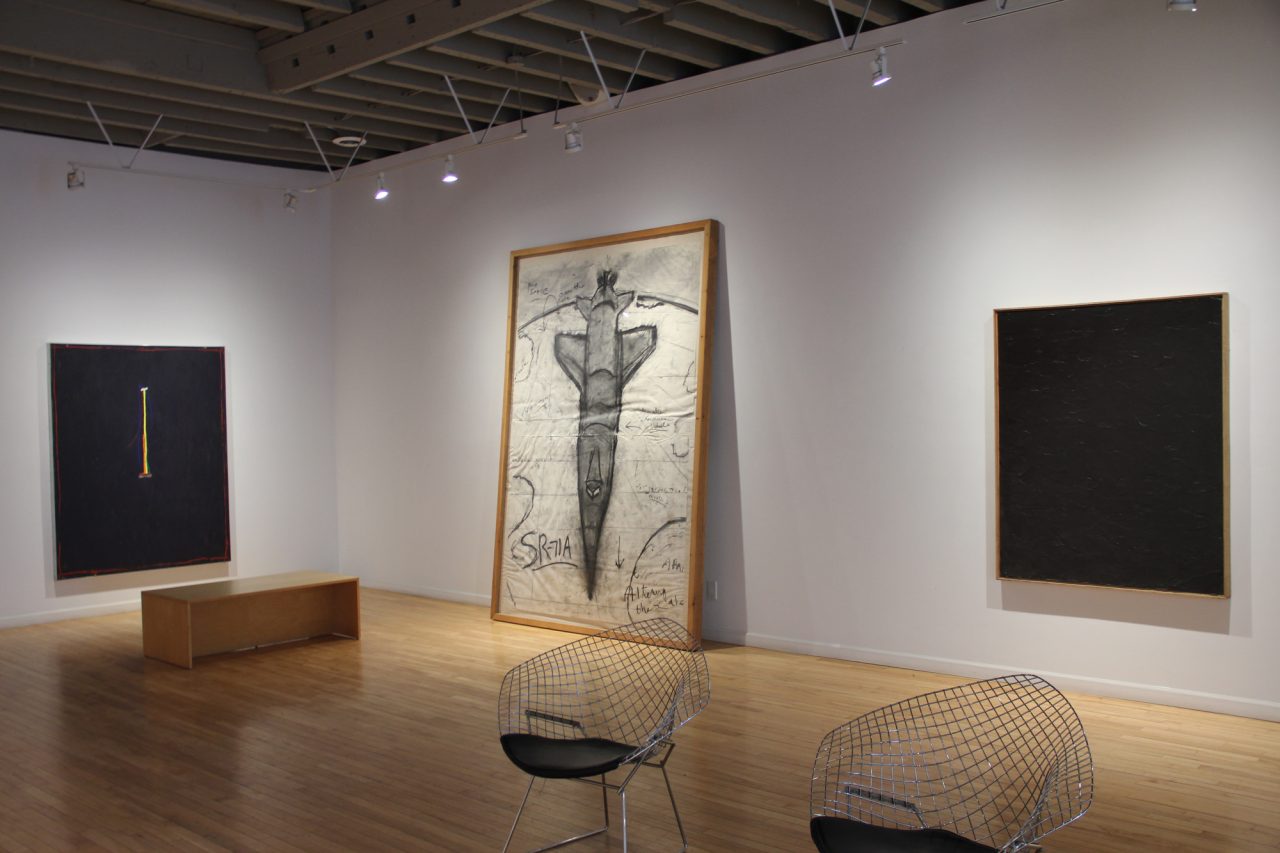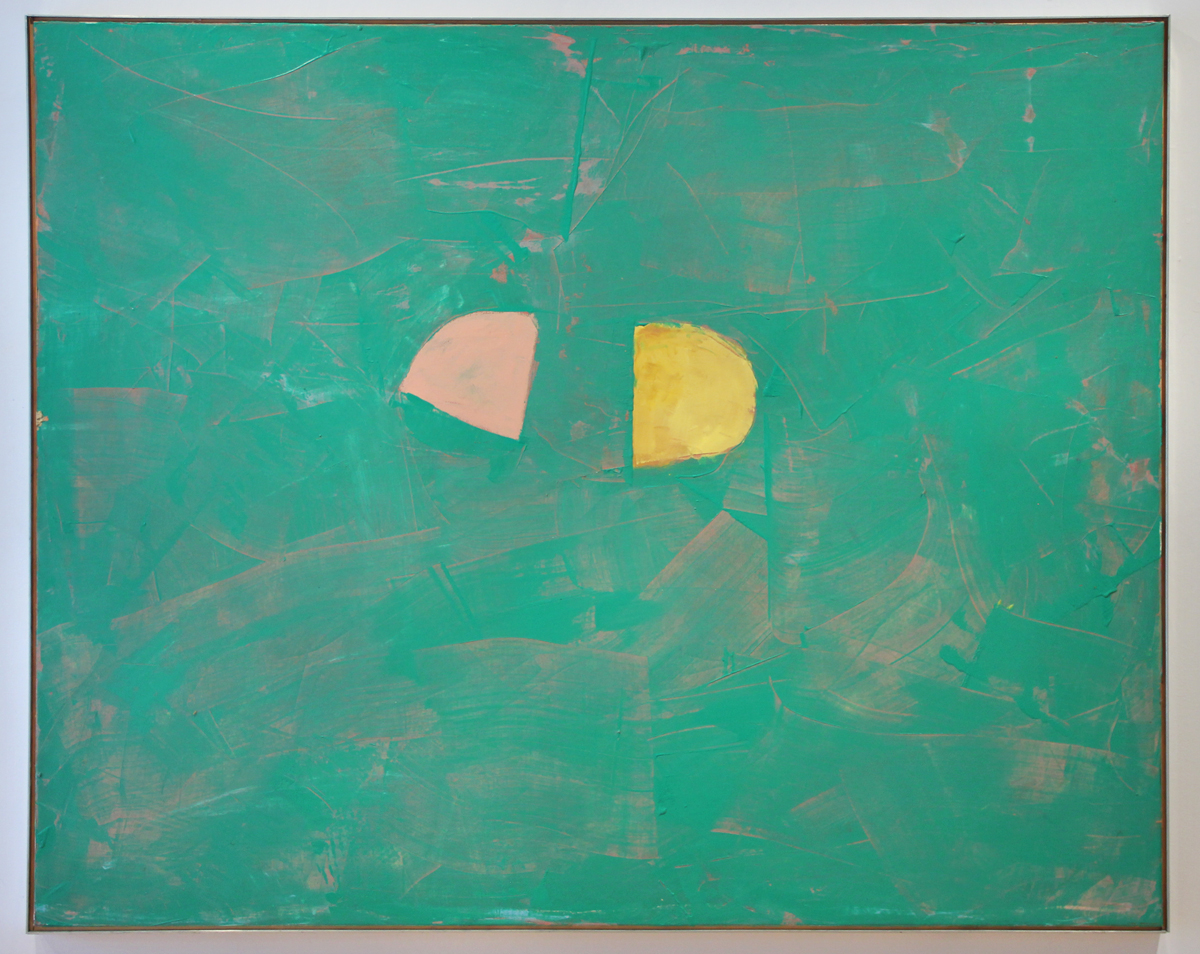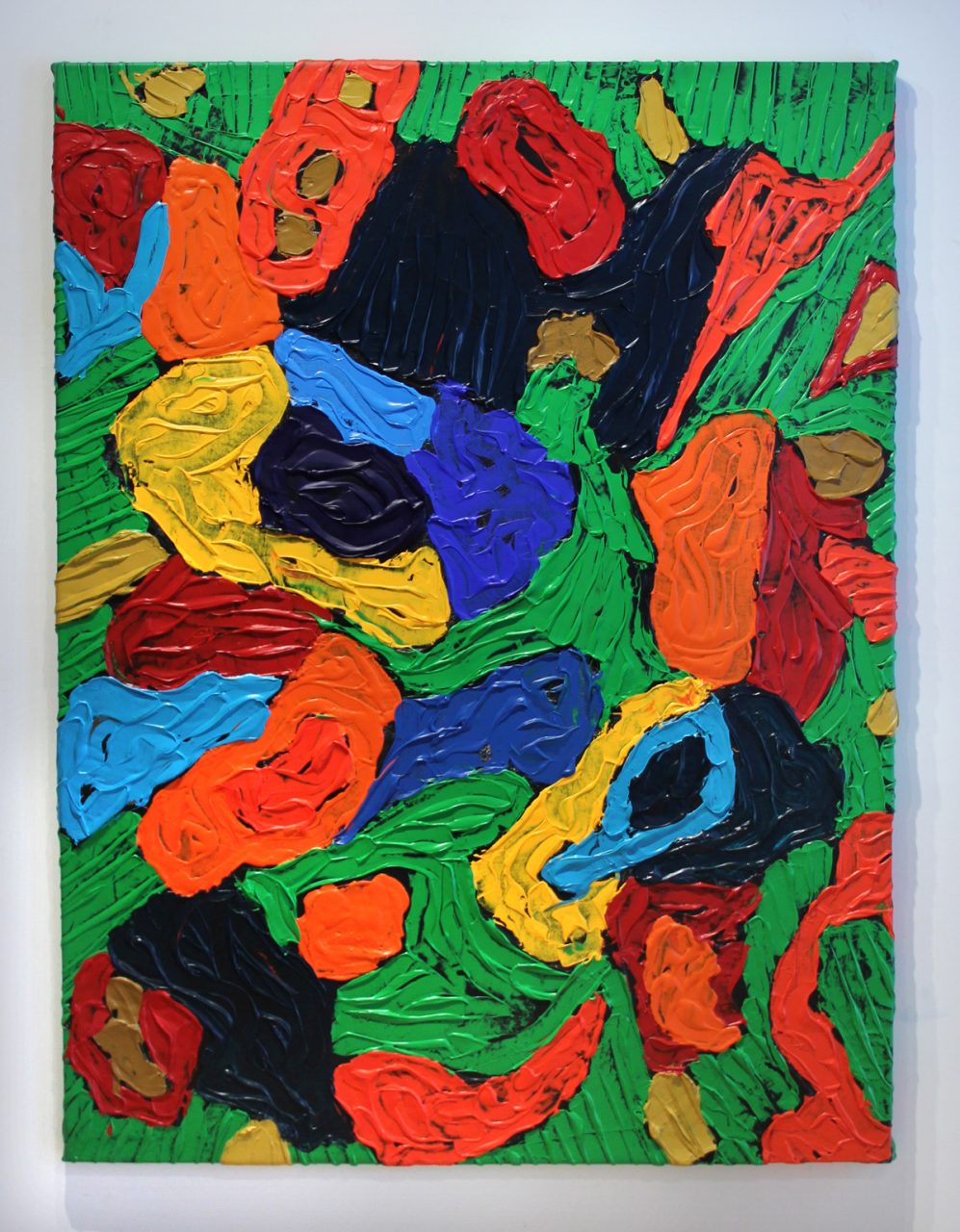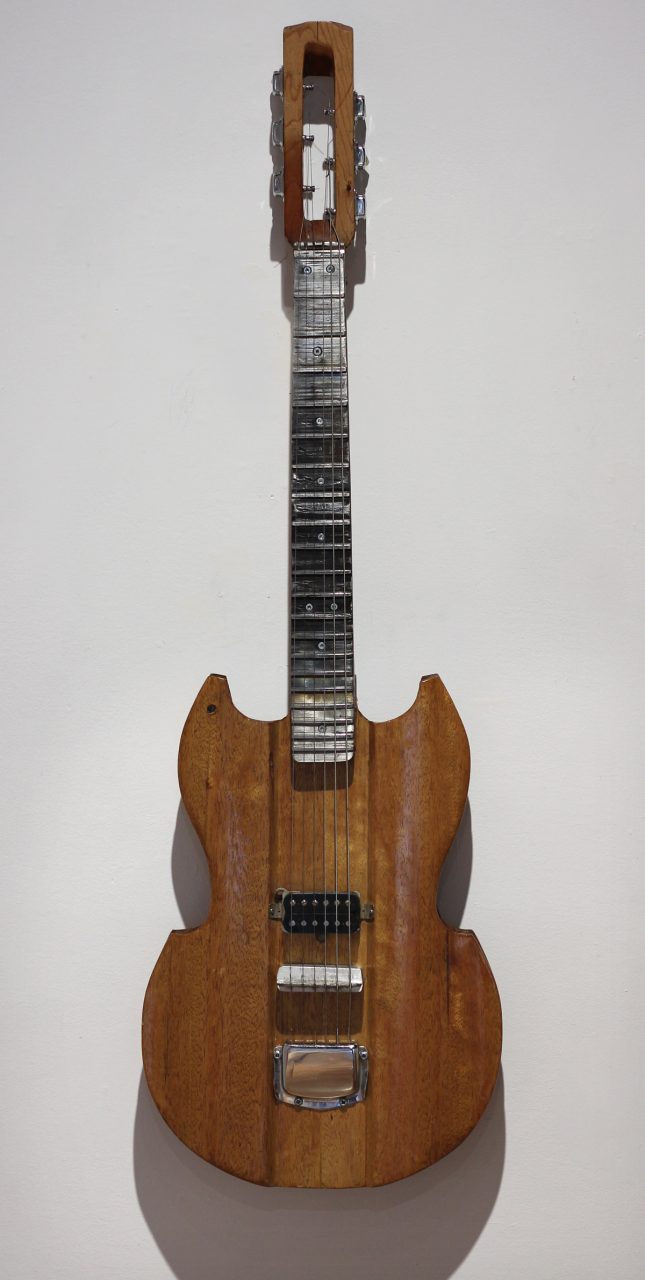“ROCKSTARS”
“ROCKSTARS” — Featuring the artists David Bolduc, Murray Favro, Ron Martin & John Scott
“Rockstar” Definition: a highly accomplished and well-regarded person, widely recognized for an outstanding talent.
For our Spring exhibition we have curated a show of four artists born between 1940 and 1950. All four artists were at one time represented by Carmen Lamanna Gallery and created visceral and now revered artworks. Completed between 1972 and 1989, the paintings and sculpture included show the artists in their prime.
We have specifically chosen artworks that are iconic representations by each artist: classic 1970 abstracts by David Bolduc, sculptural guitars by Murray Favro, one-colour black and red abstracts by Ron Martin and a monumental 1980s work on paper by John Scott.
David Bolduc
David Bolduc is best known for his colourful abstract paintings that focused on a central linear image painted over a wide variety of textured coloured backgrounds. In the 1970s his paintings consisted of layering colour over colour, dragging and pulling the paint to show through the under-colours and luscious painterly marks. The painting, “Two Poets (Miro and Apollinaire)” included in our show from 1972, is an excellent example of this technique.
The two other Bolduc’s included, painted in 1975, however, build upon this method of painting along with the introduction of his drawing of controlled lines of pure unmixed colour straight from the tube. The emphasis is both on colour and a masterful treatment of surface and a deep understanding of structure and composition.
Gary Michael Dault wrote the following review of David Bolduc’s 1975 Carmen Lamanna Gallery exhibition in artscanada magazine:
“The way this coloured drawing performs is remarkable. The enlivening of the entire painting by the presence of these crucial markings is such that it enables the viewer to see the baroque beauty of Bolduc’s generous surface really for the first time. And unexpectedly, the drawing, while it rides obviously and necessarily on top of the shifting and frequently iridescent ground, does not sit unattached and inert upon a painting surface. On the contrary, there is such a formally inventive interrelationship in these new paintings between Bolduc’s blunt drawing and his shimmering grounds that the normal figure-ground dichotomies are authoritatively transcended into unities…. The new paintings are a fine accomplishment. They’ve been worth the wait.”
David Bolduc (1945-2010) was born in Toronto and attended the Ontario College of Art for one year and then studied at the Montreal Museum of Fine Arts School (1964-65). In 1966 he returned to Toronto where he worked in the ROM’s conservation department. A Canada Council grant in 1968 allowed him to leave work and travel in Europe and Asia for eight months. Throughout his lifetime, he continued to travel extensively, often drawing inspiration from the exotic locations.
Beginning in 1967 Bolduc started showing with Carmen Lamanna Gallery and made work featuring shaped canvases painted in simple geometric colour designs. By the 1970s, however, he switched his focus to abstract canvases and quickly developed his signature style of drawing directly from the tube painted on top of a colourful stained background. The bold central image or motif was always set against a textured ground.
Bolduc’s work was exhibited extensively during his lifetime, most notably in 1977 at the Hirschhorn Museum, Washington, DC. The exhibition called “14 Canadians: a Critic’s Choice” included 42 works by 14 painters and sculptors and introduced progressive Canadian art to an American audience.
Considered part of the third generation of Toronto abstract painters which included artists such as Alex Cameron and Paul Sloggett, Bolduc remains one of Canada’s leading lyrical abstract painters.
His work is in the public collections of the Canada Council Art Bank, Beaverbrook Art Gallery, Art Gallery of Hamilton, Art Gallery of Ontario and the National Gallery of Canada.
Murray Favro
Murray Favro is one of the original members of the Nihilist Spasm Band. In the 1960s, the members started to make their own instruments to play in the sound band. As the lead guitarist, Favro also made his own guitars – first made out of painted wood, and then welded steel. Each one is left handed and uniquely shaped.
Favro is well known for making guitars that both act as a functional object and beautiful aesthetic objects. They have become the perfect synthesis of Favro the artist and Favro the inventor.
Murray Favro was born in Huntsville, ON in 1940. He moved to London as a teenager where he studied art at H. B. Beal Technical and Commercial High School. With Jack Chambers, Greg Curnoe, Ron Martin and others, Favro was part of the generation of London artists who became nationally recognized in the 1960s. He is also well known as a founding member of the Nihilist Spasm Band, which was crucial to the development of his artistic approach.
Favro is widely regarded for his highly original exploration of invention, perception and cognition. Working in drawing, sculpture, performance and installation, Favro often incorporates slide and film projections, lighting effects, and computer and electronic technology. His work involves inquisitive play and studied observation. The everyday objects that he designs and builds raise serious questions about art, technology and the nature of representation.
Around 1965 he abandoned painting for other-than-art interests – guitars, machines, airplanes, experiments with film images and inventions. A Canada Council Arts Bursary in 1970 allowed him to devote himself to his art. That year he developed his first successful “projected reconstruction,” in which images on a slide are projected onto their wooden, white, life-sized counterparts, giving them colour, detail and identity. He later produced modified inventions (Windmill Electric Generator, 1975-76; Perpetual Motion Machine, 1976-77), evolved inventions (Propeller Engine, 1978), and material, 3-dimensional renderings of airplanes (Sabre Jet, 55% Size, 1979-83).
Known for his multi-disciplinary practice, Favro’s artwork has been the subject of a major retrospective organized by the Art Gallery of Ontario in 1983 and in 1998 at the London Regional Art & Historical Museum. Murray Favro received the Gerhson Iskowitz Award in 1997 and the Governor General’s Award in Visual and Media Arts in 2007.
Ron Martin
Ron Martin was one of a small group of painters in Canada that considered the act of creating a work a type of performance, which served to remind the viewer that their experience of a material object, such as a painting, was rooted in an experience of themselves. His practice is disciplined and always begins and ends with constraints in order to articulate and explore these limits.
The one colour paintings painted between 1971-1972, such as “Alizarin-Crimson” included in “ROCKSTARS”, emphasize the relationship between light and matter and highlight the materiality and fluidity of one specific color. In this monochrome series, texture and gesture are extremely important.
Martin created clearly defined constraints before beginning each one colour painting. He would measure the quantity of paint beforehand, place the canvas on the wall (the size reflecting the range of his arm gestures) and create the painting within a specific amount of time. He would experiment with different brush sizes, arm, hand and finger gestures, density of paint and dripping.
The one colour paintings reflect a performance where the artist has left coloured traces of his physical attack on the canvas surface. The monochromatic colours create visual sensations where we, the viewer, become part of the experience of the painting.
These one colour paintings are very rare as Martin only painted a limited number of each colour.
After the one colour paintings, Martin devoted seven years of his life painting black paintings. Between 1974-1981, Martin’s only constraint was the consistency of black paint, the size of the canvas and amount of time spent painting. The paintings are gestural, material and intensely physical.
Roald Nasgaard states in “Abstract Painting in Canada”: “many are characterized by broad, sweeping gestures, first of the brush, later of the fingers and the hand, moving the paint across the surface of the canvas to cover it. Others are less gestural and more anonymously made. More than ever paint revelled in its identity. It was thick and gooey. The paint flowered and covered, yielded to or resisted and sometimes overruled the artist’s hand or the tool used to spread it. It glistened or pulled darkly in on itself.”
Into the 1980s Martin becomes interested in the phenomena of colour mass. These are his heaviest and most densely encrusted works. They are sometimes monochromatic and in the case of our “Colour Collision” painting, explores the many hues of Stevenson acrylic paint. The vibrancy and energy that he is able to produce in this human-sized canvas is remarkable.
Ron Martin (born 1943) was born in London, Ontario where he set-up his first studio with Murray Favro. He was one of the original members of the Forest City Gallery and was influenced early in his career by Greg Curnoe.
Martin has had an active studio practice since 1965 with numerous solo and group exhibitions across Canada, in New York, Germany, Japan and France. He is included in a number of major exhibitions including biennials and group exhibitions at the National Gallery and the Art Gallery of Ontario.
He is the recipient of numerous awards and grants, is an independent curator, musician and writer and is represented in numerous private and public collections including the National Gallery of Canada, Art Gallery of Ontario, Vancouver Art Gallery, Montreal Museum of Fine Arts and Museum London.
John Scott
John Scott is one of Canada’s most prolific artists known for his raw, visceral drawings that comment on the dark side of politics, war and humanity. Combining counterculture aesthetics of the late 1970s and 1980s, Scott often presents an apocalyptic vision of the world.
The monumental work on paper included in “ROCKSTARS” is a bold and graphic drawing, characteristic of his crude working methods. He would repeatedly soak paper in solvent and develop an image by grinding-in dark pigments, thick black paint, graphite and charcoal. The image of the warplane hovering over an expansive landscape comes from Scott’s interest in science fiction and technology.
He stated “I wasn’t interested [in minimalism and conceptual art]. I had a subscription, from a friend, to a military magazine, “Aviation Week & Space Technology”, pages and pages published every week. The magazine is full of ads that make you realize that the concept of a flexible, limited nuclear war, which most people think was invented by some general somewhere, is actually a market phenomenon; the B-1 is a product.” (Canadian Art, Summer 1986). These drawings that came out of his interest in militaristic oppression are complex, speak to a specific moment in time of the early 1980s and present a uniquely “John Scott” vision of the world.
Interestingly, the SR-71 reconnaissance aircraft depicted in the drawing “SR-71A” is a long-range, high-altitude Cold War spy plane that still holds the record for the world’s fastest plane. It was known for his black paint (nicknamed “Blackbird”) and its sleek design.
John Scott (born 1950) was born in Windsor, Ontario and educated at the Ontario College of Art, the Toronto arts college where he taught for 38 years. His work came to notice in 1976 in a group show at Sable-Castelli Gallery in Toronto. In 1981 he was represented by Carmen Lamanna Gallery.
Using black paint and charcoal as his main medium, Scott often repeats childlike motifs such as the “Dark Commander” and the “Terrified Bunny”, a part-rabbit / part-human figure. Hand and boot marks, misspellings and ripped or torn paper are also common features. He is also well known for his famous “Trans-Am Apocalypse No 2” (1993), a modified black-painted Pontiac Trans-Am with the Book of Revelations etched onto the surface (collection National Gallery of Canada).
Scott has exhibited extensively across Canada for the past 40 years and is collected by almost every major institution in the country including the Art Gallery of Ontario and the National Gallery of Canada. Scott’s work is also held in numerous museum and private collections outside of Canada including the Museum of Modern Art, New York.
He is the recipient of the inaugural Governor General’s Award in Visual Arts and Media in 2000.
